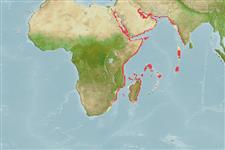Klassifizierung / Names
Namen | Synonyme | Catalog of Fishes(Gattung, Arten) | ITIS | CoL | WoRMS | Cloffa
Environment: milieu / climate zone / depth range / distribution range
Ökologie
seewasser riff-verbunden; tiefenbereich 5 - 20 m (Ref. 559). Subtropical; 30°N - 26°S, 34°E - 60°E
Western Indian Ocean: Red Sea and Persian Gulf south to Mozambique, Aldabra and Madagascar.
Size / Gewicht / Alter
Maturity: Lm ? range ? - ? cm
Max length : 17.0 cm TL Männchen/unbestimmt; (Ref. 559); max. veröff. Gewicht: 33.13 g (Ref. 124708)
Rückenflossenstacheln (insgesamt): 8; Rückenflossenweichstrahlen (insgesamt): 8-9; Afterflossenstacheln 2; Afterflossenweichstrahlen: 6 - 8. Eyes slightly larger than snout. Preopercular edge serrated, preopercular ridge smooth, weakly denticulate at angle. Brownish or silver grey. 3 darker vertical bands on each side, the first including a black ocellus with yellow or white ring, last band near the base of caudal fin.
Inhabits coastal reefs, in shallow silty areas, and in mangroves (Ref. 9710).
Life cycle and mating behavior
Geschlechtsreife | Fortpflanzung | Ablaichen | Eier | Fecundity | Larven
Mouthbrooders (Ref. 240). Distinct pairing during courtship and spawning (Ref. 205).
Tortonese, E., 1986. Apogonidae. p. 803-809. In P.J.P. Whitehead, M.-L. Bauchot, J.-C. Hureau, J. Nielsen and E. Tortonese (eds.) Fishes of the north-eastern Atlantic and the Mediterranean. UNESCO, Paris. vol. 2. (Ref. 4738)
IUCN Rote Liste Status (Ref. 130435)
Bedrohung für Menschen
Harmless
Nutzung durch Menschen
Mehr Information
ReferenzenAquakulturAquakultur ProfilZuchtlinienGenetikElectrophoresesVererbbarkeitKrankheitenVerarbeitungNutrientsMass conversion
PartnerBilderStamps, Coins Misc.LauteCiguateraGeschwindigkeitSchwimmstilKiemenoberflächeOtolithsGehirngrößeSehfähigkeit
Tools
Zusatzinformationen
Download XML
Internet Quellen
Estimates based on models
Preferred temperature (Ref.
123201): 25 - 29.1, mean 27.5 °C (based on 721 cells).
Phylogenetic diversity index (Ref.
82804): PD
50 = 0.5000 [Uniqueness, from 0.5 = low to 2.0 = high].
Bayesian length-weight: a=0.01479 (0.00690 - 0.03171), b=3.09 (2.91 - 3.27), in cm total length, based on LWR estimates for this (Sub)family-body shape (Ref.
93245).
Trophic level (Ref.
69278): 3.7 ±0.50 se; based on food items.
Widerstandsfähigkeit (Ref.
120179): hoch, Verdopplung der Population dauert weniger als 15 Monate. (Preliminary K or Fecundity.).
Fishing Vulnerability (Ref.
59153): Low vulnerability (10 of 100).
